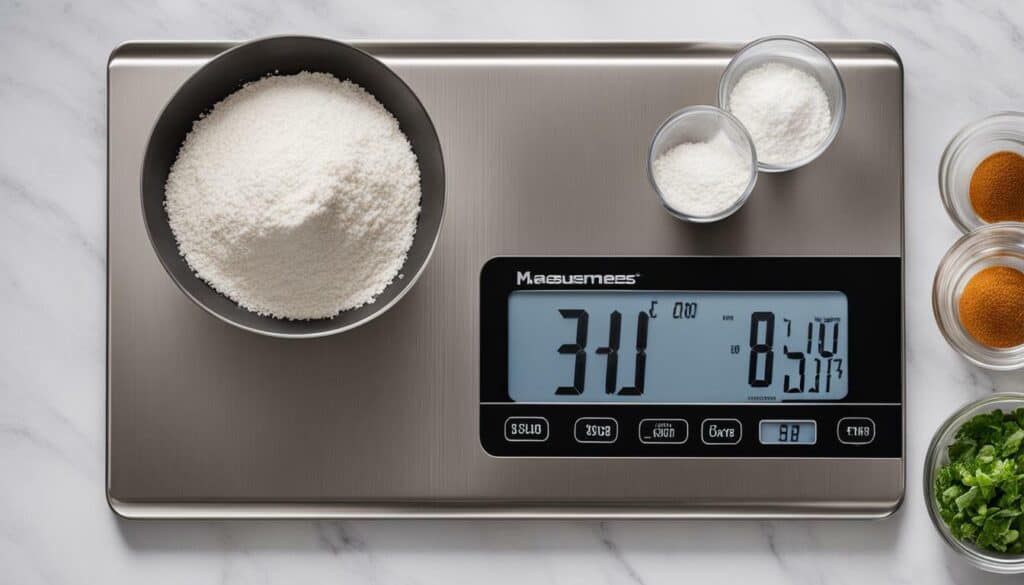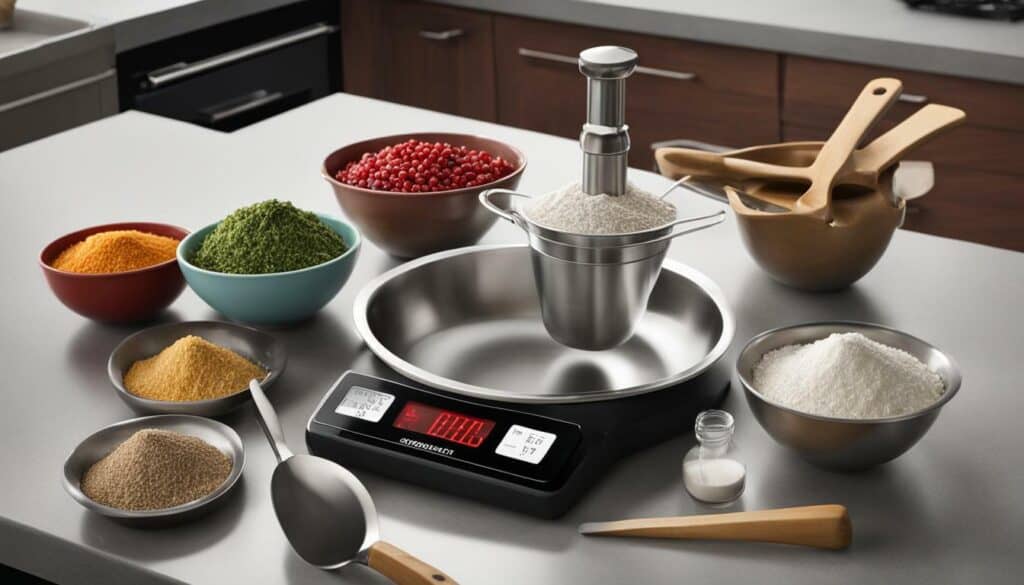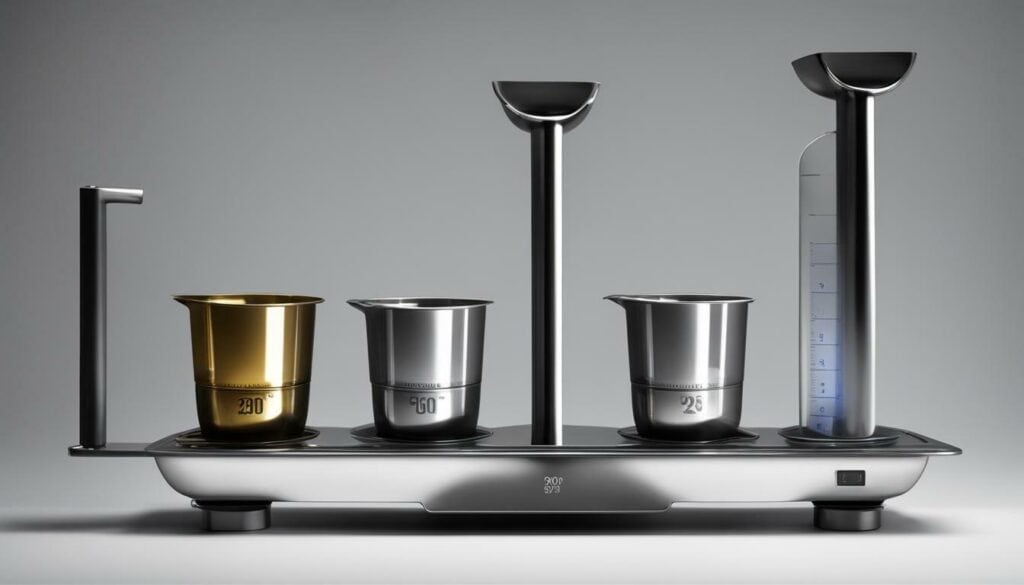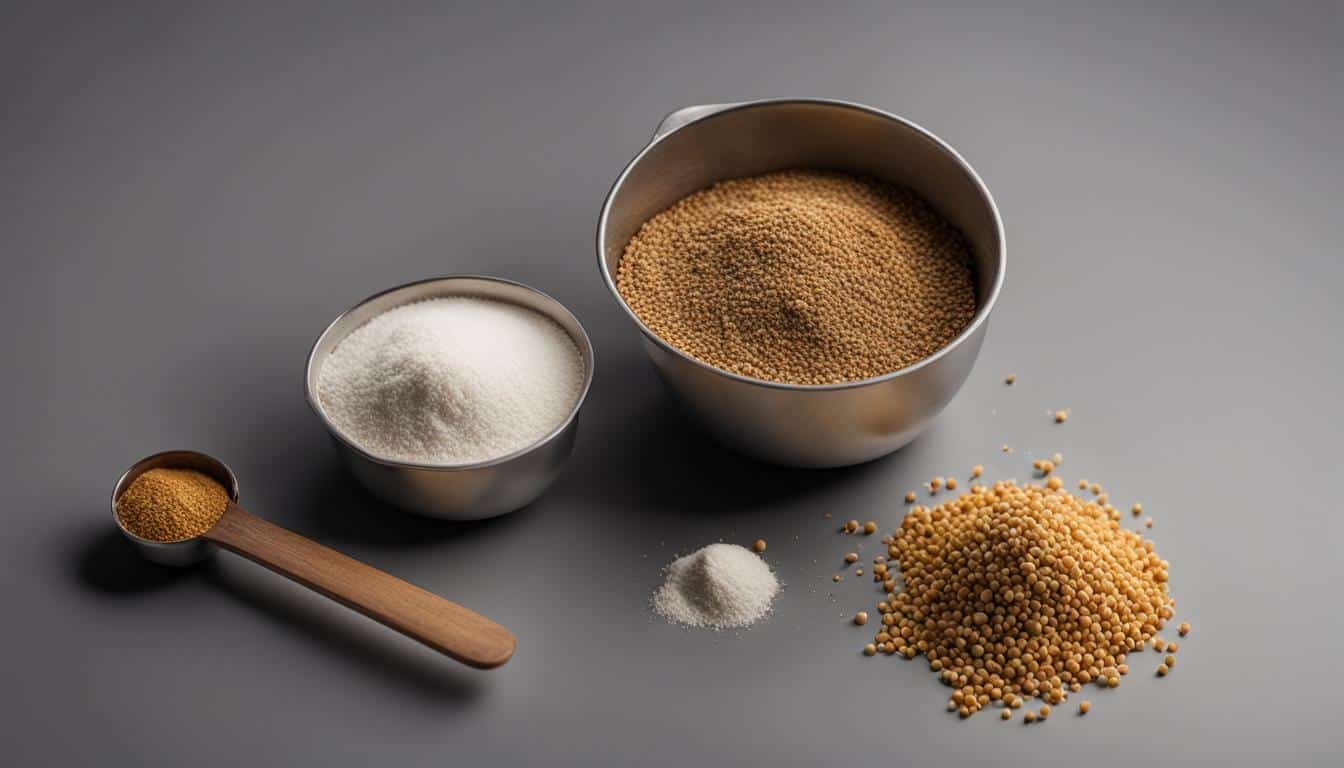Welcome to a guide on understanding measurements! If you’re wondering how many cups 230 grams is equivalent to, you’ve come to the right place. Converting between grams and cups can be a bit tricky, as grams measure mass while cups measure volume. However, there are approximate conversions for some common food items that can help you in your cooking and baking endeavors.
When converting 230 grams to cups, it’s important to consider the specific ingredient and its density. While the conversions provided here are approximate, they should give you a good starting point:
- 230 grams of water is approximately 1 cup
- 230 grams of flour is approximately 1 7/8 cups
- 230 grams of sugar is approximately 1 1/8 cups
- 230 grams of butter is approximately 1 cup
- 230 grams of milk is approximately 1 cup
- 230 grams of cocoa powder is approximately 2 1/3 cups
- 230 grams of vegetable oil is approximately 1 cup
- 230 grams of powdered sugar is approximately 1 7/8 cups
- 230 grams of honey is approximately 2/3 cup
Keep in mind that these conversions are approximate and can vary slightly depending on factors such as room temperature and ingredient quality. For more accurate results in your cooking, it’s recommended to measure dry ingredients by weight (grams). And the best and easiest way to measure 230 grams accurately is by using a kitchen scale.
Key Takeaways:
- Converting between grams and cups requires considering the specific ingredient and its density.
- Approximate conversions for common food items can serve as a starting point.
- Exact conversions may vary slightly due to factors like room temperature and ingredient quality.
- Measuring dry ingredients by weight (grams) provides more accurate results in cooking.
- Using a kitchen scale is recommended for precise measurements of 230 grams.
Exploring Grams to Cups Conversion
Converting grams to cups can be a bit tricky due to the fundamental difference between mass and volume measurements, but fear not, we’re here to shed some light on the topic. When it comes to cooking or baking, recipes often list ingredients with measurements in either grams or cups. The challenge arises when you need to convert between the two.
“How many cups are in 230 grams?” This question is frequently asked by home cooks and bakers looking for accurate measurements. While there isn’t a straightforward answer, there are approximate conversions for common food items that can help you get started. Let’s take a look at a conversion chart for grams to cups:
| Ingredient | Grams to Cups |
|---|---|
| Water | 1 cup |
| Flour | 1 7/8 cups |
| Sugar | 1 1/8 cups |
| Butter | 1 cup |
| Milk | 1 cup |
These conversions can serve as a helpful guide, but it’s important to note that they are approximate. Factors like room temperature and ingredient quality can slightly affect the measurements. To ensure the most accurate results, consider using a kitchen scale to measure dry ingredients in grams. This method provides precision and consistency, especially when working with delicate recipes that require precise measurements.

Remember, understanding measurement conversions is a valuable skill in the kitchen. While converting grams to cups may not always be as straightforward as we’d like it to be, having an approximate conversion chart and using a kitchen scale can help you achieve the best possible results in your culinary endeavors.
Specific Conversions for Common Food Items
Let’s break it down by looking at some specific food items that weigh around 230 grams and their respective cup measurements. It’s important to note that these conversions are approximate and can vary slightly depending on factors such as room temperature and ingredient quality. However, they can serve as a useful guideline when you need to convert grams to cups.
Here are the conversions for some common food items:
| Ingredient | Approximate Cup Measurement |
|---|---|
| Water | 1 cup |
| Flour | 1 7/8 cups |
| Sugar | 1 1/8 cups |
| Butter | 1 cup |
| Milk | 1 cup |
| Cocoa Powder | 2 1/3 cups |
| Vegetable Oil | 1 cup |
| Powdered Sugar | 1 7/8 cups |
| Honey | 2/3 cup |
These conversions can be helpful when you’re working with recipes that require specific measurements. However, it’s always a good idea to measure ingredients by weight (in grams) for more accurate results in cooking and baking. Using a kitchen scale is the best and easiest way to measure 230 grams accurately.

Measuring by weight provides more precise and consistent results in cooking and baking.
By understanding the conversions between grams and cups, you can confidently navigate different measurement units and ensure the accuracy of your culinary creations. Keep in mind that these conversions are approximate and may vary slightly depending on factors such as ingredient density and temperature. So, whether you’re working with water, flour, sugar, butter, milk, cocoa powder, vegetable oil, powdered sugar, or honey, use these conversions as a guide and rely on a kitchen scale for precise measurements.
Factors Affecting Measurement Conversions
While approximate conversions can be helpful, it’s crucial to keep in mind that certain factors can influence the accuracy of the measurements. One such factor is ingredient density. Different ingredients have different densities, which can affect the volume that corresponds to a specific mass. For example, 230 grams of flour will have a different volume than 230 grams of sugar, due to their varying densities.
Room temperature is another factor to consider. Temperature can affect the density of certain ingredients, especially liquids. For example, if you’re measuring 230 grams of milk, the temperature at which you measure it can slightly impact the volume. It’s important to take this into account when converting between grams and cups.
Ingredient quality can also have an impact on measurement conversions. The moisture content, freshness, and other characteristics of an ingredient can affect its weight and volume. For instance, if you’re measuring 230 grams of butter, the quality of the butter can slightly alter the conversion to cups. This is why it’s recommended to use high-quality ingredients for accurate measurements.
To ensure the most accurate measurements, it’s best to use a kitchen scale. A kitchen scale allows you to weigh ingredients precisely, eliminating the discrepancies that can occur when converting between grams and cups. Using a scale also allows for consistency in your recipes, as weight measurements are more precise and reliable than volume measurements. Invest in a reliable kitchen scale to achieve the best results in your cooking and baking endeavors.
| Ingredient | Approximate Cup Equivalent |
|---|---|
| Water | 1 cup |
| Flour | 1 7/8 cups |
| Sugar | 1 1/8 cups |
| Butter | 1 cup |
| Milk | 1 cup |
| Cocoa Powder | 2 1/3 cups |
| Vegetable Oil | 1 cup |
| Powdered Sugar | 1 7/8 cups |
| Honey | 2/3 cup |
Benefits of Measuring by Weight (Grams)
When it comes to measuring dry ingredients, using a kitchen scale and weighing in grams can make a significant difference in the outcome of your recipe. Unlike measuring by volume, which can be affected by factors such as how ingredients are packed in a measuring cup or the humidity in the air, weighing ingredients in grams provides a more accurate and consistent measurement. This is particularly important when it comes to baking, where precise measurements can greatly impact the final result.
By using a kitchen scale, you can ensure that you are using the exact amount of each ingredient as specified in the recipe. This level of precision can lead to better texture, flavor, and overall success in your culinary endeavors. Whether you’re measuring flour, sugar, or other dry ingredients, weighing them in grams allows you to achieve the desired outcome more reliably.

Not only does measuring by weight in grams provide accuracy, but it also offers convenience. Many recipes provide measurements in grams, making it easier to follow along and replicate the recipe exactly. Additionally, using a kitchen scale eliminates the need for multiple measuring cups and can help streamline your cooking process. With a quick and simple measurement, you can ensure that your dishes turn out consistently delicious.
In conclusion, when it comes to measuring dry ingredients, using a kitchen scale and weighing in grams can greatly improve the accuracy and consistency of your recipes. Whether you’re a seasoned baker or just starting out in the kitchen, investing in a kitchen scale and embracing the use of grams can elevate your cooking to new heights.
Importance of Using a Kitchen Scale
To ensure precise measurements, investing in a reliable kitchen scale is key, especially when you need to measure 230 grams accurately. Converting grams to cups can be challenging because grams measure mass while cups measure volume. However, using a kitchen scale eliminates the guesswork and provides accurate measurements.
When it comes to converting 230 grams to cups, the specific ingredient and its density play a crucial role. By weighing the ingredient on a kitchen scale, you can achieve precise results regardless of its volume. This is particularly important for baking, where accuracy is essential to achieve the desired texture and consistency.
Using a kitchen scale not only ensures accuracy but also offers convenience. Many scales come with a tare function, allowing you to measure multiple ingredients in the same bowl without the need for multiple measuring cups. It also simplifies the process of adjusting recipes, as you can easily measure ingredients in grams instead of converting them to cups.
So, if you want to accurately measure 230 grams and achieve consistent results in your cooking and baking, investing in a kitchen scale is highly recommended. It’s a valuable tool that will help you take the guesswork out of your measurements and elevate your culinary creations.

To achieve accurate conversion measurements, here are some helpful tips to keep in mind:
- Use a reliable conversion chart: Refer to a trusted conversion chart that provides accurate measurements for converting grams to cups. This will help ensure precise conversions for different ingredients.
- Adjust for ingredient density: Take into account the density of the ingredient being measured. Some ingredients, such as flour or cocoa powder, may have different densities that can affect the conversion. Use the appropriate conversion ratio based on the density of the ingredient.
- Double-check measurements: Double-check your measurements to ensure accuracy. Use a kitchen scale to weigh ingredients if possible, as this provides the most precise measurements. It’s always better to be safe than sorry when it comes to cooking and baking.
Remember, achieving precise measurements is crucial for successful culinary creations. By following these tips, you can enhance your cooking skills and ensure accurate conversions from grams to cups.

Table 1 summarizes the approximate conversions for common food items that weigh 230 grams:
| Ingredient | Approximate Conversion |
|---|---|
| Water | 1 cup |
| Flour | 1 7/8 cups |
| Sugar | 1 1/8 cups |
| Butter | 1 cup |
| Milk | 1 cup |
| Cocoa Powder | 2 1/3 cups |
| Vegetable Oil | 1 cup |
| Powdered Sugar | 1 7/8 cups |
| Honey | 2/3 cup |
Exploring the Cups to Grams Calculator
If you find yourself needing to convert cups to grams or vice versa, using a cups to grams calculator can save you time and ensure accurate results. The conversion between cups and grams can be tricky due to the difference in measuring mass and volume. However, with the help of a dedicated calculator, you can easily and conveniently convert measurements with precision.
A cups to grams calculator works by using conversion ratios specific to each ingredient. These ratios take into account the density of the ingredient, ensuring a more accurate conversion. Simply input the desired measurement in cups or grams, select the ingredient from the dropdown menu, and the calculator will provide you with the corresponding conversion.
Using a cups to grams calculator eliminates the need for manual calculations and reduces the risk of measurement errors. Whether you’re following a recipe or adjusting serving sizes, this tool can be invaluable in achieving consistent and precise results. It’s especially useful when working with ingredients that have varying densities, such as flour, sugar, or liquids like milk or oil.
| Ingredient | Cups to Grams Conversion |
|---|---|
| Water | 1 cup = 240 grams |
| Flour | 1 cup = 120 grams |
| Sugar | 1 cup = 200 grams |
| Butter | 1 cup = 227 grams |
| Milk | 1 cup = 240 grams |
Using a cups to grams calculator is simple and convenient. It ensures accuracy in your cooking and baking endeavors, allowing you to achieve the desired results every time. So the next time you find yourself needing to convert cups to grams or vice versa, make use of this handy tool for a hassle-free and precise measurement conversion.

Let’s quickly recap the essential information we’ve covered so far regarding measurement conversions and the specific conversion of 230 grams to cups. When converting between grams and cups, it’s important to understand that grams measure mass while cups measure volume. This means that the conversion is not straightforward and can vary depending on the specific ingredient and its density. However, for some common food items, there are approximate conversions available.
For example, 230 grams of water is equivalent to 1 cup. Other approximate conversions include 1 7/8 cups of flour, 1 1/8 cups of sugar, 1 cup of butter, 1 cup of milk, 2 1/3 cups of cocoa powder, 1 cup of vegetable oil, 1 7/8 cups of powdered sugar, and 2/3 cup of honey. It’s important to note that these conversions provide a rough estimate and can vary slightly depending on factors such as room temperature and ingredient quality.
Measuring dry ingredients by weight in grams provides more accurate results in cooking and baking. Using a kitchen scale is the best and easiest way to measure ingredients like 230 grams accurately. A kitchen scale allows for precise measurements, taking into account the weight of the ingredient rather than relying solely on volume measurements. By using a scale, you can achieve consistent results in your culinary endeavors.

- The conversion of 230 grams to cups depends on the specific ingredient and its density.
- Approximate conversions are available for common food items, but they are not exact.
- Measuring dry ingredients by weight in grams provides more accurate results.
- Using a kitchen scale is the best way to measure 230 grams accurately.
By understanding measurement conversions and using accurate measurements, you can elevate your cooking and baking skills. Whether you’re following a recipe or experimenting with your own creations, knowing how to convert between grams and cups can make a significant difference in the outcome of your dishes. So, grab your kitchen scale, measure those 230 grams precisely, and enjoy the delicious results!
Conclusion
Now that you have a better understanding of measurement conversions and how many cups 230 grams is equivalent to, you’re ready to step up your cooking game with confidence. Remember, converting between grams and cups is not always straightforward due to the difference in measuring mass and volume. However, for some common food items, we provided approximate conversions to help you get started.
For example, 230 grams of water is equal to 1 cup, while other conversions include 1 7/8 cups of flour, 1 1/8 cups of sugar, 1 cup of butter, 1 cup of milk, 2 1/3 cups of cocoa powder, 1 cup of vegetable oil, 1 7/8 cups of powdered sugar, and 2/3 cup of honey. It’s important to note that these conversions are approximate and can vary slightly based on factors like room temperature and ingredient quality.
To achieve more accurate results in cooking, consider measuring dry ingredients by weight in grams. This method provides precise and consistent measurements, leading to better culinary outcomes. Using a kitchen scale is the best and easiest way to measure 230 grams accurately, ensuring your recipes turn out just the way you intended.
So go ahead and explore the world of measurement conversions, armed with the knowledge and confidence to create delicious dishes and baked goods. With accurate cooking measurements, your culinary endeavors are sure to impress!
FAQ
Q: How do I convert 230 grams to cups?
A: Converting grams to cups depends on the specific ingredient and its density. However, for some common food items, approximately 230 grams is equal to 1 cup of water, 1 7/8 cups of flour, 1 1/8 cups of sugar, 1 cup of butter, 1 cup of milk, 2 1/3 cups of cocoa powder, 1 cup of vegetable oil, 1 7/8 cups of powdered sugar, and 2/3 cup of honey. Keep in mind that these conversions are approximate and can vary slightly.
Q: Why is the conversion between grams and cups not straightforward?
A: Grams measure mass, while cups measure volume. Since different ingredients have different densities, the conversion between grams and cups is not always precise. It’s important to consider factors such as ingredient density, room temperature, and ingredient quality when converting between grams and cups.
Q: Why is it more accurate to measure dry ingredients by weight (grams)?
A: Measuring dry ingredients by weight in grams provides more accurate results in cooking. This is because weight measurements eliminate inconsistencies caused by variations in ingredient volume due to factors like sifting, compression, and settling. Using a kitchen scale to measure dry ingredients ensures precise and consistent results.
Q: What are some factors that can affect measurement conversions?
A: Measurement conversions can be affected by factors such as ingredient density, room temperature, and ingredient quality. These factors can cause slight variations in the volume of a substance, leading to slightly different conversions. It’s important to be aware of these factors and make adjustments accordingly for more accurate results.
Q: How can I achieve accurate measurement conversions?
A: To achieve accurate measurement conversions, it’s helpful to use conversion charts, adjust for ingredient density if necessary, and double-check measurements to ensure precision. It’s also recommended to use a kitchen scale for more accurate results, especially when dealing with weight measurements like grams.
Q: What is a cups to grams calculator and how can I use it?
A: A cups to grams calculator is a tool that helps convert measurements from cups to grams. It provides a convenient way to quickly and accurately convert ingredients based on their specific density. To use a cups to grams calculator, simply enter the value in cups and select the ingredient from the provided options. The calculator will then display the equivalent weight in grams.
Q: Why is it important to understand measurement conversions in cooking?
A: Understanding measurement conversions is crucial in cooking to ensure accurate and consistent results. Using the correct measurements helps in maintaining the right balance of ingredients, achieving desired flavors and textures, and following recipes correctly. Accurate measurements are essential for successful and delicious cooking.
How Many Calories are in a Cup of Chocolate Fudge?
Wondering about the calories in chocolate fudge revealed? A cup of chocolate fudge contains approximately 450 to 500 calories, making it a treat that should be enjoyed in moderation. Indulging in this decadent delight can certainly satisfy your sweet tooth, but remember to balance it with a healthy lifestyle.





Leave a Reply